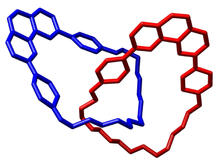Jean-Pierre Sauvage
Jean-Pierre Sauvage (born October 21, 1944 in Paris ) is a French chemist ( supramolecular chemistry ). He is a pioneer in the field of mechanically interlocked molecular structures ( Mechanically Interlocked Molecules , MIM), such as chain formations and molecules with topology of nodes. In 2016, he and Fraser Stoddart and Ben Feringa received the Nobel Prize in Chemistry for “the design and synthesis of molecular machines ”.
life and work
In 1967 he graduated from the National Chemistry School in Strasbourg (today ECPM Strasbourg ). Sauvage received his PhD from the University of Strasbourg under Jean-Marie Lehn and was a post-doctoral student at the University of Oxford with MLH Green. He then went back to Strasbourg, where he was Research Director of the CNRS . From 1971 he did research for the CNRS , from 1979 as research director. In 1981 he became a professor in Strasbourg. In 2009 he retired .
In 2009/2010 he was visiting professor at the University of Zurich , where he received an honorary doctorate in 2010, and visiting scholar at Northwestern University from 2010 to 2012 .
He is interested in applications such as the reconstruction of photosynthetically active reaction centers with transition metal complexes and porphyrins and in the topology of molecular machines, molecular switches, and synthetic molecular motors . In 1983 he published a revolutionary new synthesis route for catenanes using metal complex templates and in a similar way he succeeded in 1989 in the synthesis of a molecular knot with Christiane Dietrich-Buchecker (clover leaf knot). From the beginning of the 1990s, he systematically synthesized catenanes with up to seven rings.
Catenanes and rotaxanes (developed by Fraser Stoddart ), which are not coupled by rigid covalent bonds, but mechanically, which gives them freedom of movement, are the starting points for the development of artificial molecular switches (Stoddart) and motors (first Ben Feringa 1999).
He received the Prelog Medal . He has been a corresponding member of the Académie des sciences since 1990 and a full member since 1997, and a foreign member of the National Academy of Sciences since 2019 . He is a Knight of the Legion of Honor and received the bronze medal in 1978 and the silver medal of the CNRS in 1988.
literature
- J. Fraser Stoddart : The master of chemical topology. In: Chemical Society Reviews . Volume 38, No. 6, 2009, pp. 1521-1529, doi: 10.1039 / b819336n
Fonts
- Jean-Pierre Sauvage, Christiane Dietrich-Buchecker (Eds.): Molecular Catenanes, Rotaxanes and Knots , Wiley-VCH 1999
Web links
- Jean-Pierre Sauvage on the website of the Académie des sciences
- Jean-Pierre Sauvage. Machine et moteurs moléculaires, de la biologie aux molécules de synthèse. Le Monde.fr, June 20, 2006
- Curriculum Vitae at the Academie des Sciences, with list of publications, pdf
Individual evidence
- ^ JP Collin, Sauvage: Electrochemical reduction of carbon dioxide mediated by molecular catalysts. In: Coordination Chemistry Reviews . Volume 93, 1989, pp. 245-268
- ↑ Christine Dietrich-Buchecker, MC Jimenez-Molero, V. Sartor, J.-P. Sauvage: Rotaxanes and catenanes as prototypes of molecular machines and motors. In: Pure and Applied Chemistry . Volume 75, 2003, pp. 1383-1393
- ^ CO Dietrich-Buchecker, Sauvage, JP Kintzinger: Une nouvelle famille de molécules. Les métallo-caténanes. In: Tetrahedron Letters . Volume 24, 1983, p. 5095
- ↑ CO Dietrich-Buchecker, Sauvage, JM Kern: Templated synthesis of interlocked macrocyclic ligands: The catenands. In: Journal of the American Chemical Society . Volume 106, 1984, p. 3043
- ^ M. Cesario, CO Dietrich-Buchecker, J. Guilhem, C. Pascard, and JP Sauvage: Molecular structure of a catenand and its copper (I) catenate: complete rearrangement of the interlocked macrocyclic ligands by complexation. In: Journal of the Chemical Society . Chemical Communications. 1985, pp. 244-247
- ↑ Sauvage: Les caténands. In: Nouveau Journal de Chimie . Volume 9, 1985, p. 299
- ↑ CO Dietrich-Buchecker, J.-P. Sauvage: A Synthetic Molecular Trefoil Knot. In: Angewandte Chemie International Edition . Volume 28, 1989, pp. 189-192
| personal data | |
|---|---|
| SURNAME | Sauvage, Jean-Pierre |
| BRIEF DESCRIPTION | French chemist |
| DATE OF BIRTH | October 21, 1944 |
| PLACE OF BIRTH | Paris |


